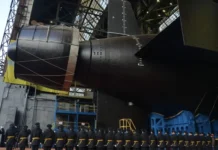
The U.S. military faces a critical vulnerability that could determine the outcome of any future conflict in the Indo-Pacific. While Force Design and joint modernization efforts have produced a more capable fighting force, the Sea Services have failed to remedy systemic shortfalls within their logistics enterprise. (From: US Naval Institute.)
This assessment applies not only to potential Ukraine-like conflicts, but also to the far more demanding task of fighting a naval campaign in the Indo-Pacific. As a Marine logistician who has operated alongside our Marines facing sustainment challenges across the theater, I write from direct experience: Logistics remains the Sea Services’ operational Achilles’ heel.
Shortfalls in logistics are not just a naval issue; all the service chiefs routinely acknowledge them. As the services work together to develop the logistics capabilities and capacity the joint force needs, learning from the war in Ukraine will not be sufficient. Building the logistics enterprise necessary to prosecute a campaign in the Indo-Pacific will require answers from the past. The October 1944 Battle of Leyte Gulf demonstrates how U.S. forces must be able to sustain themselves, while conducting distributed air and maritime operations in a future campaign of similar magnitude.
The Road to Leyte Gulf
While the Mariana Islands Campaign and, later, Peleliu are better known to most Marines, the operational effects of the Battle of the Philippine Sea and the Formosa Air Battle played a bigger role in the ultimate downfall of Imperial Japan. Success in the Marianas enabled the forward deployment of U.S. bombers with sufficient reach to hit mainland Japan. And the near-total destruction of Imperial Japan’s naval air forces in the Philippine Sea battles deprived Japan of what today’s planners would call maritime intelligence, surveillance, and reconnaissance (ISR), precision strike, and operational reach. Most important for the United States, the victories in the Philippine and Taiwan Seas created strategic options, while eliminating them for the adversary.
The most important option was an early assault and capture of the Philippines, which would sever Japan from the oil it required from the Dutch East Indies. Vice Admiral Takeo Kurita, commander of the First Diversionary Task Force (Main Effort) at Leyte, noted, “If you seized the Philippines, it would cut off all fuel supply to the Empire, and that all fuel supply being severed, the war in all areas south of the Empire must end.”1 Combined Fleet Commander Admiral Soemu Toyoda acknowledged the same after the war, stating that if the Philippines were lost and the sea lines of communications (SLOCs) between the Dutch East Indies and Japan broken, the fleet would become irrelevant through lack of oil.2
Admiral Toyoda was on the horns of a dilemma. If he sought a surface battle without the protection or ISR afforded by carrier aviation, he was choosing certain defeat, based on lessons from the recent battles of the Coral Sea, Midway, Eastern Solomons, and Santa Cruz.3 If he chose to avoid a general engagement and not protect his SLOCs, his fleet would become a coastal defense force with ever-dwindling stores of ammunition. Toyoda chose battle, specifically to contest the anticipated allied invasion of the Philippines and protect the SLOCs. But because of the extreme shortages of aircraft, aircrew, and aviation fuel, he would lack the scouting necessary to determine when and where that invasion would take place. Choosing battle risked destruction of his fleet without any hope for a strategic success. At best, he would temporarily disrupt and delay the continued U.S. advance toward Japan.
By summer 1944, Japan’s logistical challenges had become insurmountable. Lack of fuel and tankers reduced the fleet’s ability to refuel at sea, limiting its striking range to 2,500 nautical miles.4 To make matters worse, from May to September 1944, U.S. submarines and carrier aviation sank 18 Imperial Japanese Navy (IJN) fleet tankers, further inhibiting IJN freedom of action.5 In addition to those tanker losses, in the first half of September, Japan lost 127 merchant ships of all classes to U.S. strikes.6 Clearly, “Logistics decided when, where, and how the Combined Fleet could fight.”7
At the same time, U.S. forces were enjoying naval logistical superiority akin to their ever-expanding naval air superiority. After an unopposed landing, naval construction battalions turned Ulithi Atoll into Third Fleet’s main advanced logistics base. From this anchorage operated a logistics train of more than 100 ships, designated Task Group 30.8, which included no fewer than nine oilers at any time and similar numbers of ammunition ships. It enabled persistent operations at a tempo the Combined Fleet could not match. Those oilers, stationed close to Task Force (TF) 38 yet out of range of Japanese land-based aircraft, constantly refueled the carrier task forces. On average, U.S. carrier task forces were refueled every three to five days, and thus in no way had their operational or strategic decisions limited by sustainment.8 All this meant the U.S. combat power advantage was so overwhelming it created a systemic shock absorber sufficient to overcome any minor tactical setback, poor command decision, or temporary lack of situational awareness. U.S. logistics ensured eventual strategic success and enabled commanders to be both bold in their planning and accepting of higher risks.
This history reveals the challenges and opportunities facing naval forces today. While the IJN’s logistical failures offer cautionary lessons, U.S. success at Leyte Gulf provides a blueprint for modern planners. Seven key lessons emerge, each directly applicable to the challenge of a potential fight in the western Pacific.
Lesson #1: Logistics will be a determining variable in any future conflict in the Indo-Pacific. Logistics could decide when, where, and how the joint force and naval forces would fight in the Indo-Pacific. The former Commander, U.S. Army Forces Pacific, General Charles Flynn, agreed and focused on setting the theater by prepositioning stocks and conducting other activities to build interior lines.9 The Marine Corps is engaged in similar activities, including modernization of the global positioning network (GPN) with prepositioned stocks afloat and ashore. The GPN seeks to recreate the same shock-absorber the Navy enjoyed in 1944 by building a networked supply web that could sustain forces regardless of a break or disruption in any link of the supply chain, including access to aerial refuelers.
Creating such a web will require new uncrewed air, surface, and undersea systems and a more distributed posture than currently exists. It will limit the urge to recreate an “iron mountain,” as was done at Ulithi. Building additional iron mountains is strategically and operationally unsound; we have too many already. A GPN that includes ashore, afloat, and undersea stocks will provide strategic options to the fleet and joint force. It will generate and sustain aviation readiness; and it will sow confusion among adversary commanders. The Marine Corps’ GPN actions, alongside the Army’s efforts to set the theater, will help ensure the adversary cannot determine how and where U.S. naval forces will fight.
Lesson #2: U.S. fighter aircraft must have access to refueling, in the air, on land, and at sea. Toyoda and Kurita understood refueling was essential to power projection and operational reach. While the United States maintains a large fleet of aerial refuelers, adversary air defenses threaten those aircraft, and they cannot operate alongside the aircraft they exist to support—a concern members of Congress raised during 2025 budget hearings. Both the Air Force and Navy have been working for years to develop solutions, such as the carrier-based MQ-25A Stingray unmanned refueling aircraft, but these have been slow to arrive and not at the scale needed.
In addition to Navy and Air Force efforts, the Marine Corps has been experimenting for years with expeditionary forward arming and refueling points (FARPs) as part of its expeditionary advanced base operations (EABO). While the strike and sensing capabilities of Marine EABs will be important in a future conflict, their ability to function as FARPs may be more consequential. Collectively, these efforts must move faster.
Lesson #3: Reloading and rearming at sea will be essential. In October 2024, former Secretary of the Navy Carlos del Toro hailed a proof-of-concept transfer and reload of 25-foot vertical launch system missile canisters from the USNS Washington Chambers (T-AKE-11) to the USS Chosin (CG-65) as “transforming the way the Navy fights.”10 This capability must be scaled up and made widely available across the fleet. Such an at-sea reload capability would be a modern equivalent of Task Group 30.8’s never-ending supply of ammunition for Third Fleet in 1944 and provide a similar source of operational and strategic advantage. Eliminating the need to send a cruiser or destroyer back to Japan, Guam, or even Hawaii to reload would provide the equivalent of more ships to the battle fleet and put “more players on the field.”
Lesson #4: Naval logistics facilitates and sustains lethality. At Leyte Gulf, U.S. forces boasted 16 fleet and light carriers, 18 escort carriers, and 1,500 carrier aircraft, but perhaps their most overwhelming advantage was the logistical support that enabled perpetual action and freedom of maneuver. Unfortunately, over the past several decades the need for oilers and ammunitions ships has been downplayed, and most questions about fleet size and force structure have emphasized warship lethality. Fortunately, current senior leaders understand the warfighting advantages created by support ships such as the John Lewis–class fleet replenishment oilers and continue to fight for additional appropriations for their construction. As the administration and the Navy push for a larger fleet, logistics—including innovative uncrewed solutions—must be a cornerstone of fleet design. Support ships make power projection and distributed maritime operations a reality. They are part of the system that generates lethality.
The readiness lessons from World War II naval logistics, captured by Rear Admiral Henry Eccles in his classic works from the 1950s, remain salient. Eccles described logistics readiness as “the ability to undertake, to build up and thereafter to sustain, combat operations at the full combat potential of the forces which are assigned to the combat commanders.”11 Implicitly, he assumed all the essential tasks would have to happen under combat conditions, in actively contested spaces. The ability of today’s Fleet Marine Force to meet a high-end contingency depends on all the external logistics dependencies and networks being ready. Aircraft, ship, and battalion readiness on the first day of a conflict will quickly become an irrelevant metric if the logistics system is not ready to sustain it.
Lesson #5: All ships are survivable or vulnerable depending on the system in which they are employed. Questions about the survivability of a class of ships or aircraft are unhelpful. The IJN battleships Atago and Mushashi were extremely lethal and survivable by the standards of 1944 and 2024. The Atago was sunk by four torpedoes and the Mushashi absorbed 19 torpedoes and 17 bomb hits before going to the bottom. What doomed those ships was not a lack of lethality, structural survivability, or defensive armaments, but rather the lack of a larger support system including combat air patrols, situational awareness, and air superiority. The U.S. Navy had already denied those elements through system-destruction warfare.
Long before China’s military chose to emphasize system-confrontation and system-destruction warfare, U.S. naval forces engaged in a systematic campaign to destroy the IJN. Many in the U.S. military have forgotten the lesson that what makes a ship or naval capability survivable or relevant is not simply its organic attributes, but rather the overall system of which it is a part. Consider the actions of the ships and aircraft of the Dwight D. Eisenhower Carrier Strike Group during its 2023–24 deployment in the Red Sea.12 That system of aircraft, destroyers, the carrier itself, advanced intelligence and communications capabilities, and the logistics that supported it made the Ike survivable and lethal. Thus, critics who question the survivability of amphibious ships, fleet oilers, medium landing ships, and even carriers miss the larger issues of air superiority, antisubmarine warfare, domain awareness, and signature management, which are more important to a ship’s overall survivability. These same attributes apply to the network of U.S. bases and stations.
Lesson #6: Operational design and strategy matter more than tactical engagements. The combined actions of U.S. and allied forces prior to the Battle of Leyte Gulf placed the IJN on the horns of a dilemma. The Japanese could accept either battle and likely destruction or inaction and ultimate defeat. Planning for potential conflict in the Indo-Pacific, U.S. military leaders must engage in operational design to place adversaries on similar horns and leave them with no path to victory. Applying this 1944 lesson, the Navy and Marine Corps today must deny China and its navy access to nondomestic natural resources, especially those that travel across the oceans. The Navy and Marine Corps must expand their ability to seize, hold, and deny key SLOCs. Exploiting operational and strategic vulnerabilities and complicating adversary decision cycles is the essence of maneuver warfare and superior design.
Lesson #7: Challenge all assumptions, no matter how long their lifespan or endurance. U.S. and Japanese actions at Leyte were the culmination of years of combat. Assumptions were tested, validated, and reevaluated as conditions changed. As Admiral Raymond Spruance said, “When we started planning in the summer of 1943 for operations in the Central Pacific, it was obvious that the geography of the area which we hoped to capture had characteristics very different from those of the South Pacific. . . . This geography meant that the logistic support for our fleet . . . would have to be primarily afloat.”13
Many of the underlying assumptions about how the Navy and Marine Corps operate and sustain today’s force were developed during the post-Cold War U.S. unipolar moment, which has long since ended. Unfortunately, concepts of force projection and operational sustainment have not yet fully adapted to the reality that unfettered access to any theater is increasingly illusive. Today, maintaining critical systems, including exquisite aviation platforms such as the F-35, depends on the ability to move maintenance personnel and parts. Planners must embrace the fact that changing conditions, circumstances, and adversary capabilities have invalidated earlier assumptions, such as the ability to rely on contractor-provided aviation maintenance and logistics.
The war in Ukraine and conflict in the Red Sea have demonstrated the changing character of warfare, but lessons from today’s conflicts cannot overshadow lessons from the last time the United States fought a peer adversary across the vast distances of the Pacific. Those lessons must be continually revisited and applied to current combat development and modernization efforts. The most decisive naval battle of World War II proved to be the Battle of Leyte Gulf, which was fought and ultimately won in large measure by logistics. The same will likely be true of any major naval engagement in the Indo-Pacific in the future.
1. C. Vann Woodward, The Battle for Leyte Gulf: The Incredible Story of World War II’s Largest Naval Battle (New York: Skyhorse Publishing, 2007), 20.
2. Mark E. Stille, Leyte Gulf: A New History of the World’s Largest Sea Battle (Oxford: Osprey Publishing, 2023), 47.
3. The Battle of the Coral Sea was fought in May 1942; the Battle of Midway, June 1942; the Battle of the Eastern Solomons, August 1942; and the Battle of the Santa Cruz Islands, October 1942. All four battles witnessed major carrier versus carrier engagements.
4. There are 3,326 nautical miles between Guam and Hawaii, and 2,889 nautical miles between Tokyo and Singapore.
5. Stille, Leyte Gulf, 97.
6. Stille, 101.
7. Stille, 253.
8. Stille, 85–86.
9. See General Flynn’s comments at the CSIS Strategic Landpower Dialogue in October and December 2023.
10. Gidget Fuentes, “Navy Conducts First Successful Tests Reloading and Rearming Warships at Sea,” USNI News, 15 October 2024.
11. RADM Henry E. Eccles, USN “Logistics in the National Defense,” Naval War College Review 12, no. 9, (November 1959).
12. Open-source reporting from the Eisenhower Strike Group’s deployment credits the strike group with destroying no fewer than 100 Houthi missiles and drones.
13. RADM Worral Reed Carter, USN (Ret.), Beans, Bullets and Black Oil: The Story of Fleet Logistics Afloat in the Pacific During World War II (Washington, DC: Department of the Navy, 1953), viii.







